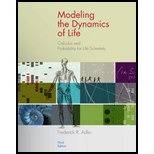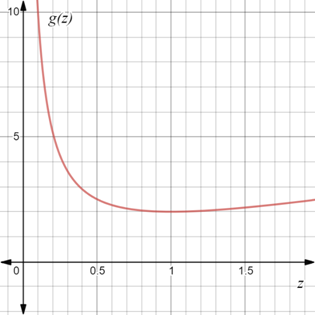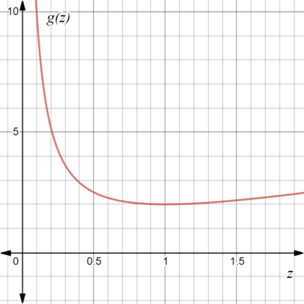
To calculate: The first and second derivative of the function
Answer to Problem 20E
The value of first derivative of the function is

Explanation of Solution
Given information:
The function
Formula used:
Let a function g be continuous on closed interval
If first derivative of the function is greater than zero that is
If first derivative of the function is less than zero that is
If second derivative of the function is greater than zero that is
If second derivative of the function is less than zero that is
The point where the graph changes it nature is known as the point of inflection.
Power rule of differentiation,
Calculation:
Consider the provided function
Rewrite the function with help negative exponent that is,
Evaluate the first derivative of the function.
Apply sum rule of differentiation,
Apply the power rule of differentiation,
Evaluate the second derivative of the function, differentiate the first derivative again with respect to z .
Apply sum rule of differentiation,
Apply the power rule of differentiation,
Recall if first derivative of the function is greater than zero that is
If first derivative of the function is less than zero that is
If second derivative of the function is greater than zero that is
If second derivative of the function is less than zero that is
To sketch the graph of the function
Observe that first derivative of the function
Equate
When
When
So,
Next observe that second derivative of the function
Therefore, the graph of the function

Thus, the value of first derivative of the function is
Want to see more full solutions like this?
Chapter 2 Solutions
Modeling the Dynamics of Life: Calculus and Probability for Life Scientists
- 18.11. If f(z) is analytic and |f(z)| ≤1/(1-2) in || < 1, show that |f'(0)| ≤ 4.arrow_forwardSCAN GRAPHICS SECTION 9.3 | Percent 535 3. Dee Pinckney is married and filing jointly. She has an adjusted gross income of $58,120. The W-2 form shows the amount withheld as $7124. Find Dee's tax liability and determine her tax refund or balance due. 4. Jeremy Littlefield is single and has an adjusted gross income of $152,600. His W-2 form lists the amount withheld as $36,500. Find Jeremy's tax liability and determine his tax refund or balance due. 5. 6. Does a taxpayer in the 33% tax bracket pay 33% of his or her earnings in income tax? Explain your answer. In the table for single taxpayers, how were the figures $922.50 and $5156.25 arrived at? .3 hich percent is used. 00% is the same as multi- mber? 14. Credit Cards A credit card company offers an annual 2% cash-back rebate on all gasoline purchases. If a family spent $6200 on gasoline purchases over the course of a year, what was the family's rebate at the end of the year? Charitable t fractions, decimals, and 15. al Percent…arrow_forward1.5. Run Programs 1 and 2 with esin(x) replaced by (a) esin² (x) and (b) esin(x)| sin(x)|| and with uprime adjusted appropriately. What rates of convergence do you observe? Comment.arrow_forward
- Use Taylor Series to derive the entries to the pentadiagonal and heptadiagonal (septadiagonal?) circulant matricesarrow_forward1.3. The dots of Output 2 lie in pairs. Why? What property of esin(x) gives rise to this behavior?arrow_forward1.6. By manipulating Taylor series, determine the constant C for an error expansion of (1.3) of the form wj−u' (xj) ~ Ch¼u (5) (x;), where u (5) denotes the fifth derivative. Based on this value of C and on the formula for u(5) (x) with u(x) = esin(x), determine the leading term in the expansion for w; - u'(x;) for u(x) = esin(x). (You will have to find maxε[-T,T] |u(5) (x)| numerically.) Modify Program 1 so that it plots the dashed line corresponding to this leading term rather than just N-4. This adjusted dashed line should fit the data almost perfectly. Plot the difference between the two on a log-log scale and verify that it shrinks at the rate O(h6).arrow_forward
- Define sinc(x) = sin(x)/x, except with the singularity removed. Differentiate sinc(x) once and twice.arrow_forward1.4. Run Program 1 to N = 216 instead of 212. What happens to the plot of error vs. N? Why? Use the MATLAB commands tic and toc to generate a plot of approximately how the computation time depends on N. Is the dependence linear, quadratic, or cubic?arrow_forwardShow that the function f(x) = sin(x)/x has a removable singularity. What are the left and right handed limits?arrow_forward
- 18.9. Let denote the boundary of the rectangle whose vertices are -2-2i, 2-21, 2+i and -2+i in the positive direction. Evaluate each of the following integrals: (a). 之一 dz, (b). dz, (b). COS 2 coz dz, dz (z+1) (d). z 2 +2 dz, (e). (c). (2z+1)zdz, z+ 1 (f). £, · [e² sin = + (2² + 3)²] dz. (2+3)2arrow_forward18.10. Let f be analytic inside and on the unit circle 7. Show that, for 0<|z|< 1, f(E) f(E) 2πif(z) = --- d.arrow_forward18.4. Let f be analytic within and on a positively oriented closed contoury, and the point zo is not on y. Show that L f(z) (-20)2 dz = '(2) dz. 2-20arrow_forward
 Algebra and Trigonometry (MindTap Course List)AlgebraISBN:9781305071742Author:James Stewart, Lothar Redlin, Saleem WatsonPublisher:Cengage LearningAlgebra & Trigonometry with Analytic GeometryAlgebraISBN:9781133382119Author:SwokowskiPublisher:Cengage
Algebra and Trigonometry (MindTap Course List)AlgebraISBN:9781305071742Author:James Stewart, Lothar Redlin, Saleem WatsonPublisher:Cengage LearningAlgebra & Trigonometry with Analytic GeometryAlgebraISBN:9781133382119Author:SwokowskiPublisher:Cengage

 Trigonometry (MindTap Course List)TrigonometryISBN:9781337278461Author:Ron LarsonPublisher:Cengage Learning
Trigonometry (MindTap Course List)TrigonometryISBN:9781337278461Author:Ron LarsonPublisher:Cengage Learning Functions and Change: A Modeling Approach to Coll...AlgebraISBN:9781337111348Author:Bruce Crauder, Benny Evans, Alan NoellPublisher:Cengage Learning
Functions and Change: A Modeling Approach to Coll...AlgebraISBN:9781337111348Author:Bruce Crauder, Benny Evans, Alan NoellPublisher:Cengage Learning





